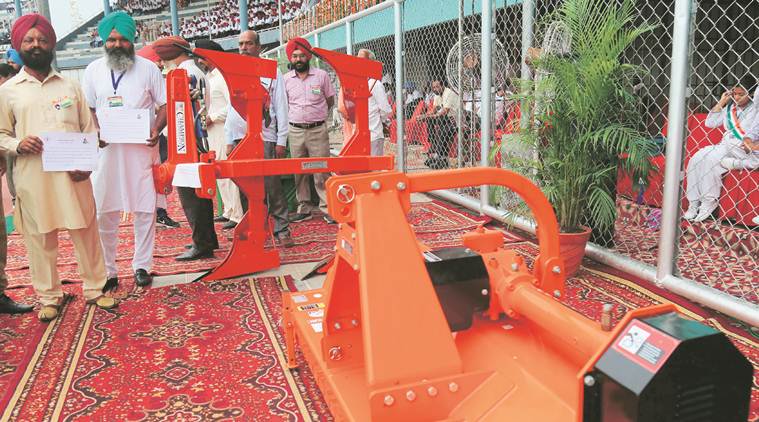 Subsidised machinery for in-situ straw management bought by farmers at a function in Ludhiana. (Photo: Gurmeet Singh)
Subsidised machinery for in-situ straw management bought by farmers at a function in Ludhiana. (Photo: Gurmeet Singh)
With just one-and-a-half months to go for harvesting of the paddy crop, both the Punjab government and the Centre are working overtime to ensure there are enough machines in the fields that will keep burning of leftover straw — a major source of air pollution in the National Capital Region — within tolerable limits.
The state government has, until now, sanctioned a total of 19,081 machines that would qualify for subsidised purchases, based on applications received from individual farmers, farmer producer groups, cooperatives and private custom hiring centres. As against these applications, orders have been placed for 14,026 machines — Happy Seeder, Super-Straw Management System (S-SMS), chopper, mulcher, cutter-cum-slasher and hydraulically reversible mould board plough — for manufacture by equipment makers. But, as on August 15, a mere 485 machines were actually delivered to end-users, who would have paid the applicable subsidised rates on these.
The Centre had, in March, approved a Rs 1,151-crore scheme to promote in-situ management of crop residue – through cutting and evenly spreading the straw on the field or incorporation into the soil — as opposed to burning. Out of this fund, to be spent in 2018-19 and 2019-20, Rs 695 crore was earmarked for Punjab and remaining for Haryana, Uttar Pradesh and Delhi.
Under the scheme, the users are supposed to deposit the subsidised price amount with the agriculture department once their applications are cleared. They can, then, place orders with the machinery manufacturers who will, however, have to bear the interest cost on the balance amount till they receive it as subsidy from the government.
“The deliveries are happening at a slow place because the buyers, especially farmers, are not depositing even subsidised price money, which they were to before August 31. And with the government also not reimbursing the balance subsidy on time, it means we have to spend from our own pockets. Blocking so much of capital for long is simply unaffordable,” said Harmail Singh, president of the Punjab State Agricultural Implements Manufacturers Association.
The 19,081 machines sanctioned isn’t too low relative to the target of 25,000 machines set for the current fiscal. Nor are the orders placed low. But with manufacturers not getting their monies — whether the upfront share from buyers or government subsidy — delivering the machines even by September 30 (the earlier deadline was August 31) is looking to be a herculean task.
“We have so far received Rs 270 crore from the Centre and are seeking another Rs 150 crore for this fiscal, to enable us clear the rush of applications,” stated Jasbir Singh Bains, director of agriculture, Punjab government. The subsidy is 50 per cent on purchases by individual farmers, while it is 80 per cent if the orders are placed by cooperatives, farmer producer groups and custom hiring centres.
Paddy harvesting in Punjab begins from around October 15. Since harvesting is done using combines, which operate at 50-60 cm above the ground, they leave behind standing stubble that cannot be easily disposed of. Farmers usually burn both the left-over and the loose paddy straw. The latter also has limited use, as it cannot be finely cut or made into bhusa (chaff) like wheat straw. Punjab alone generates 22-23 million tonnes of paddy during the kharif season, out of which 85-90 per cent in burnt – and within a narrow time frame from mid-October to November 10.
If there aren’t enough machines on the field by end-September that can prevent stubble burning by farmers, it would be difficult to expect an end to Delhi’s air pollution woes — at least this year.